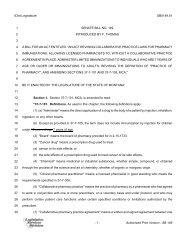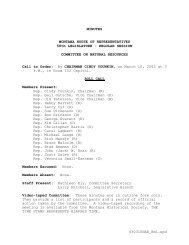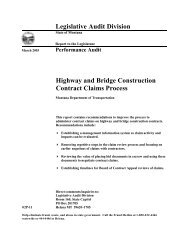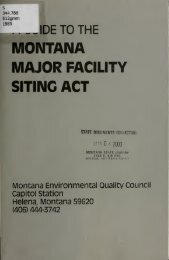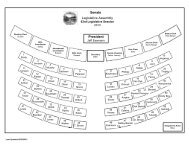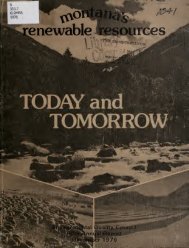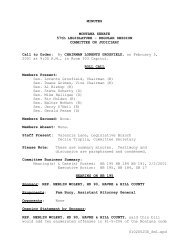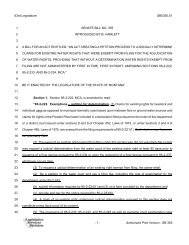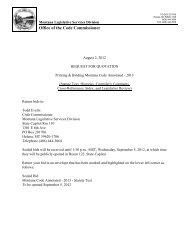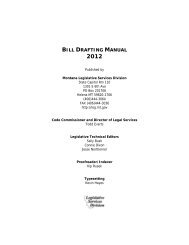Public Comment. Volume III - Montana Legislature
Public Comment. Volume III - Montana Legislature
Public Comment. Volume III - Montana Legislature
You also want an ePaper? Increase the reach of your titles
YUMPU automatically turns print PDFs into web optimized ePapers that Google loves.
Impact Analysis Studies and Proposed Mitigation Approach Page 2 .<br />
1.2 Site Description<br />
MCFH occupies a 242.25 acre site located west of Miles City, <strong>Montana</strong>. The land is used<br />
for hatchery facilities, related residential units, and un-grazed rangelands (MDSL et al.<br />
1989). The land is composed of two parcels obtained from the U.S. Fish and Wildlife<br />
Service (USFWS) and the National Park Service via the Land and Water Conservation<br />
Fund (LWCF). MT DFWP made an initial investment of $5 million to upgrade the<br />
hatchery for warm-water culture from 1987 to 1989 (MDSL et al. 1989). Since 1989<br />
FWP has made an additional investment of $1,500,000 to expand the number of rearing<br />
ponds at the site and other hatchery facilities. These improvements increased production<br />
capacity appreciably, but also brought the production area much closer to the proposed<br />
railway centerline. Four more one-acre ponds and a new boiler were added in 1999 at a<br />
. cost of $900,000 to enhance bass production to meet current requests (G. Bertellotti, MT<br />
DFWP personal communication, 1999). Two supply pipelines provide primary and<br />
secondary water sources for the 46 earthen ponds, 8 raceways, 320 incubation jars, 62<br />
early rearing tanks, and other facilities at the MCFH.<br />
1.3 Annual Budget and Revenues<br />
In fiscal year (FY) 1999, MCFH had an annual budget of $207,086.60 for all direct costs,<br />
a 28% decrease from the previous year (MT DFWP 1999). Approximately 70% of<br />
annual funding comes from Federal Dingell-Johnson Restoration Grant funds, with the<br />
remaining 30% of funding coming from state license revenues. In February of 1989, Jeny<br />
Blackard, Deputy Assistant Regional Director for Federal Aid for the USFWS, expressed<br />
concerns regarding any TRR-related damages to hatchery structures built with Federal<br />
Aid funds. According to Mr. Blackard, there is real potential for MT DFWP to lose<br />
Federal Aid hnding if MT DFWP loses control of these facilities including the water<br />
supply pipeline. This was confirmed by the Assistant Regional Director for Federal Aid<br />
(Mary Gessner) in a letter to MT DFWP on June 3, 1998 (See attached letters). Although<br />
it is not clear whether TRR operational impacts would constitute a "loss of control", if<br />
construction or operation compromised adequate maintenance, caused declines in<br />
production, or prevented MT DFWP from making timely repairs to facilities built with<br />
Federal Aid monies, including Dingell-Johnson funds, the MT DFWP could lose the<br />
source of a substantial portion of their annual funds. Without appropriate mitigation<br />
measures in place to ensure such impacts do not occur and funding is not jeopardized,<br />
MT DFWP cannot grant an easement.<br />
Fishing in <strong>Montana</strong> is a common recreational activity with 45% of residents participating<br />
in a fishing activity at least once during the year, 27 % of that participation attributable to<br />
non-fly fishing activities, and 5% attributable to ice-fishing (Ellard et al. 1999).<br />
<strong>Montana</strong>'s reservoirs attract many out of state visitors as well, and surrounding<br />
communities benefit from revenues generated by fishing.<br />
EQC Eminent Domain Study -223-



